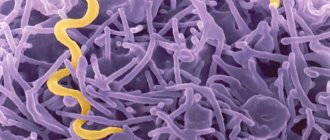The enzyme immunoassay (ELISA) method is a blood test that allows you to identify food intolerance. Its development is associated with the body's production of IgG class immunoglobulins - specific antibodies that are produced by cells of the immune system in case of intolerance to certain foods.
Food intolerance is a negative reaction of the body that occurs in response to eating a certain food. The toxic effects of poorly digested foods, which are perceived by the body as foreign agents, lead to the appearance of unpleasant symptoms: disruption of the gastrointestinal tract, swelling, skin problems, increased fatigue. Scientists have recently included food intolerance in the list of the most pressing problems in clinical and preventive medicine.
To diagnose food intolerance, quantitative determination of IgG subclasses of specific antibodies to individual food antigens is used.
Based on the results of the blood test, the doctor will make a list of allowed and prohibited foods for the patient, which will help to eat properly, without negative health consequences, and at the same time it will be possible to prepare delicious dishes from those foods that do not cause unwanted reactions.
In the clinical diagnostic laboratory ON CLINIC, food intolerance tests are performed with a wide range of products that can cause allergies. Food additives (preservatives, dyes, thickeners) are also tested. The result of the analysis is given to the patient as soon as possible.
List of potential allergens tested for
Egg white, egg yolk, cow's milk, beta-lactoglobulin, casein, blue cheese, goat's milk, yogurt, soft cheese, Atlantic cod, Atlantic herring, rainbow trout, northern shrimp, salmon, squid, Atlantic mackerel, carp, pike perch, black and red caviar, wheat flour, rye flour, oat flour, rice, buckwheat flour, corn, gluten/gliadin, millet, champignon, peas, sesame seeds, soybeans, pork, beef, chicken, lamb, orange, tangerine , garlic, onion, celery, mustard, tomato, carrots, potatoes, white cabbage, cauliflower, cucumber, beets, eggplant, pumpkin, cabbage mixture, green and black olives, peanuts, walnuts, hazelnuts, almonds, pistachios, banana, pear, apple, peach, pineapple, kiwi, apricot, strawberry, cherry, raspberry, red and black currant, melon and watermelon, grapes, black and green tea, rose hips, brewer's yeast, hops, malt, baker's yeast, chocolate , coffee, lecithin, glutamate, aspartame - hsa, sugar, spice mixture No. 1 (red pepper (chili), red capsicum (paprika), cayenne pepper, allspice, chili pepper), peppercorn mixture, spice mixture No. 2 (bay leaf, dill, parsley, parsley root), candida albicans, ascaris.
The difference between intolerance and allergy
PN can be defined as the body's inability to digest certain types of foods. In case of allergies, any amount of a dangerous product immediately triggers a response from the immune system.
Food allergies are expressed by skin manifestations (so-called diathesis in children), swelling of the mucous membranes, nasal congestion, and later nausea and diarrhea. To accurately identify the disease, a comprehensive allergen analysis is performed.
The characteristic features of PN are:
- Slowness of reaction to the consumed product. The main difficulty in understanding the causes and identifying foods to which one is intolerant is that small doses do not cause a reaction. The response may appear a considerable time after ingestion and after repeated use.
- The start of the reaction occurs gradually and increases slowly.
- The list of products can constantly expand.
- To detect intolerance, you need to consume a large dose of the product at once.
- PN often occurs on the simplest types of food that are present in the daily diet.
Doctors believe that intolerance is more dangerous than allergy, since its symptoms are less obvious and delayed, and are more difficult to correct. In particular, dairy intolerance is caused by a lack of lactase. This enzyme is responsible for the breakdown of milk sugars.
What both conditions have in common is that the reaction does not occur to spoiled food containing toxins and harmful microorganisms, but to completely fresh food. Another common point is that the conditions are chronic and cannot be cured. It is necessary to exclude substances that provoke conditions from the diet.
Video about food allergies from Dr. Komarovsky:
Indications for testing for food intolerance
Symptoms of food intolerance are very diverse in their manifestations. Manifestations of food intolerance include:
- problems with the functioning of the gastrointestinal tract - bloating, frequent constipation, diarrhea;
- nausea, vomiting, discomfort in the mouth;
- heartburn – the lining of the esophagus may become irritated due to the body’s inability to properly absorb problematic foods;
- acne, rashes, red spots on the skin, dark circles under the eyes and other problems with skin, hair and nails;
- headaches, which are especially often diagnosed when the body is unable to digest foods containing gluten, lactose or sugar;
- joint pain, muscle aches;
- swelling of the mucous membranes;
- decreased blood pressure;
- increased irritability, lethargy, fatigue, drowsiness.
According to scientific research, most modern people need to be tested for food intolerance, because the modern human body is forced to work to the limit of its capabilities. Every day we filter the food that enters the gastrointestinal tract and often do not notice or ignore the fact that some foods are not suitable for us. Year after year, we gradually develop food hypersensitivity, even to foods that can be considered a healthy diet.
In the absence of obvious signs of allergy, the test is recommended for anyone who wants to:
- improve metabolism;
- normalize hormonal levels;
- increase tone;
- strengthen the immune system;
- reduce and stabilize your weight;
- improve the condition of skin, hair and nails;
- slow down the aging process;
- improve the body's health.
Understanding IgE, allergies and what IgG means
A food allergy is a reaction to food proteins.
They can be classified as immunoglobulin E (IgE)-mediated (immediate) reactions, non-IgE-mediated (delayed) hypersensitivity reactions, and mixed reactions. IgE-mediated reactions are the ones we worry about when we hear about “food allergies”: flushing, skin itching, wheezing, vomiting, throat swelling and even anaphylaxis. These reactions can occur immediately after exposure and are a consequence of the interaction of allergens with IgE located on mast cells. The interaction causes the release of inflammatory chemicals such as histamine and leukotriene, causing an allergic reaction that is usually associated with the skin (itching, swelling and rash), but can also be anaphylactic.
Not all reactions follow this cascade. Non-IgE-mediated allergic reactions can cause local (eg, contact dermatitis) or generalized reactions, which are usually gastrointestinal or dermatological in nature. Celiac disease is a non-IgE allergic reaction. Finally, some allergic disorders are both IgE and non-IgE mediated, such as atopic dermatitis (eczema).
In addition to IgE-mediated reactions, there are a number of possible reactions to food that can be called "food intolerances." Not based on the immune system, they are more common than allergies. These include conditions such as lactose intolerance, gastroesophageal reflux (GERD), enzyme deficiencies, metabolic conditions, infections and other processes. It is an all-encompassing term by definition.
So where does immunoglobulin G (IgG) come from? IgG molecules mediate cell interactions with various cellular and humoral mechanisms. IgG antibodies indicate exposure to foods, not allergies. Some studies suggest that IgG may be a marker of food intolerance rather than intolerance.
- Children with eczema and egg or milk allergies with higher milk/egg IgG levels were more likely to tolerate these products later in life.
- Resolution of cow's milk allergy is associated with an increase in IgG
- A study showed an increase in IgG levels in patients undergoing oral immunotherapy for milk or peanut allergies.
This research is ongoing. But given the lack of correlation between the presence of IgG and the physical manifestations of the disease, IgG testing is considered unproven as a diagnostic tool because the results have no clinical utility as a tool for dietary modification or food elimination.
Verification of evidence
I have been trying to understand the literature supporting the IgG blood test.
There are no links on the Gemocode website, and the term Gemocode does not appear in Pubmed. Yorktest cites a placebo-controlled study that it claims shows a reduction in IgG test symptoms in patients already diagnosed with irritable bowel syndrome (IBS). This result has been criticized for numerous shortcomings, suggesting that the effectiveness of the test in this group remains to be established. In light of the lack of published clinical trials validating the hemocode or Yorktest, I sought consensus opinions and statements on IgG testing from allergy specialists and immunologists. Here's what I found by highlighting:
From the American Academy of Allergy, Asthma and Immunology and the American College of Allergy, Asthma and Immunology: Allergy Diagnostic Testing: Updated Practice Parameter:
IgG and IgG antibody tests for food allergies are not clinically relevant, are not validated, lack sufficient quality control, and should not be performed.
And also from the American Academy of Allergy, Asthma and Immunology (AAAAI) Practice Paper, “Current Approach to the Diagnosis and Treatment of Adverse Reactions to Food.”
Some tests are considered unproven for diagnosing specific food allergies. Those for which there is no evidence of validity include challenge neutralization, cytotoxic tests, muscle response testing (applied kinesiology), electrodermal testing, reagin pulse testing, and chemical analysis of body tissues. Measuring food-specific IgG antibodies has also not been proven as a diagnostic tool.
From the European Academy of Allergy and Clinical Immunology:
Testing for IgG4 in the blood against a variety of foods involves large-scale screening of hundreds of foods using enzyme-linked immunosorbent assays and radioallergosorbent assays in young children, adolescents, and adults. However, many serum samples show positive IgG4 results without corresponding clinical symptoms. These data, coupled with the lack of convincing evidence for the histamine-releasing properties of IgG4 in humans and the lack of any controlled studies of the diagnostic value of IgG4 testing in food allergy, provide no basis for the hypothesis that food-specific IgG4 should be attributed to an effector role in food hypersensitivity. Contrary to contested beliefs, anti-food IgG4 indicates that the body has been repeatedly exposed to food components that are recognized by the immune system as foreign proteins. Its presence should not be considered as a factor causing hypersensitivity, but rather as an indicator of immunological tolerance associated with the activity of regulatory T cells. In conclusion, food-specific IgG4 does not indicate an (inevitable) food allergy or intolerance, but rather a physiological response of the immune system following exposure to food components. Therefore, IgG4 testing in foods is considered inappropriate for the laboratory treatment of food allergies or intolerances and should not be performed in the case of food-related complaints.
From the National Institute of Allergy and Infectious Diseases, Guidelines for the Diagnosis and Treatment of Food Allergies in the United States:
4.2.2.9. Non-standard and unproven procedures; Guideline 12: The (Expert Panel) recommends that none of the following non-standardized tests be used for the routine assessment of IgE-mediated (food allergy):
- Basophil histamine release/activation
- Lymphocyte stimulation
- Facial thermography
- Gastric juice analysis
- Endoscopic allergenic provocation
- Hair analysis
- Applied kinesiology
- Provocation neutralization
- Allergen-specific IgG4
- Cytotoxicity Assay
- Electrodermal test (Vega)
- Transmitter release assay (LEAP diet)
Australian Society of Clinical Immunology and Allergy (ASCIA):
Comment: Food-related IgG antibodies are commonly detected in healthy adults and children, regardless of the presence of food-related symptoms. There is no reliable evidence that measuring IgG antibodies is useful in diagnosing food allergies or intolerances, nor that IgG antibodies cause symptoms. In fact, IgG antibodies reflect exposure to an allergen, but not the presence of a disease. An exception is that anti-gliadin IgG antibodies are sometimes useful for monitoring adherence to a gluten-free diet in patients with histologically confirmed celiac disease. Otherwise, misuse of a food allergy test (or misinterpretation of results), for example in patients with inhalant allergy, may lead to inappropriate and unnecessary dietary restrictions, particularly with nutritional consequences for children. Despite studies showing the futility of this method, it continues to be promoted in the community, even for diagnosing disorders for which there is no evidence of immune system involvement.
Allergy Society of South Africa Position Statement: ALCAT and IgG Allergy and Intolerance Tests:
We continually consult with colleagues, funders, and healthcare practitioners regarding the reliability and appropriateness of the ALCAT and IgG food allergy tests for patients with suspected allergies and other disorders. We would like to provide the following information to magazine readers and the public. Manufacturers and suppliers of the ALCAT and IgG test claim that the tests have diagnostic value in identifying substances responsible for allergic and intolerance reactions. These tests are sold directly to the public and health care providers, claiming that they are more effective than traditional skin prick tests or specific serum IgE tests, especially for delayed allergic reactions. The manufacturers of the ALCAT test claim that orthodox allergy practice does not recognize delayed allergic reactions, when in fact it is generally accepted that these reactions play a role in up to 30% of the spectrum of allergic reactions!
To date, neither ALCAT nor IgG have shown predictive value in the diagnosis of allergy or intolerance.
and!
A second test that is poorly documented is the IgG test for food allergies. The specific definition of IgE and its diagnostic value have been documented for over three decades as specific to allergic disorders. Although IgG does play a role in the allergic response, there is no evidence that it has diagnostic value in predicting food allergens or other substances that may affect people. The IgG test is also marketed as effective for predicting foods associated with attention deficit disorder and obesity. There is no published evidence for these claims.
I also found review papers from immunologists and allergy specialists:
From the Department of Pediatric Pneumology and Immunology, Charité University Children's Hospital, Berlin: Unproven diagnostic procedures for IgE-mediated allergic diseases:
Determination of specific IgG antibodies in serum does not correspond to oral nutritional requirements. In cases of cow's milk intolerance confirmed by oral infection, elevated IgG antibodies were not detected. The levels of milk-specific IgG antibodies in children with early and late types of clinical reactions are the same. Additionally, there is no evidence that IgG subclasses or IgE/IgG4 antibody ratios are reliable diagnostic tools. A study of 27 children with chicken egg allergy found that children with a positive challenge test tended to have a higher IgE/IgG 4 ratio and a higher IgG1/IgG4 ratio than children with a negative challenge test, but concluded that oral provocations are still necessary to confirm the diagnosis of food allergy. A large study of 601 newborns, infants, children and adults found that testing for IgA and IgM antibodies was not helpful in diagnosing food allergy. Because IgG antibodies to common dietary antigens can be found in health and disease, testing for dietary IgG has no clinical significance and should not be part of the diagnostic test for food allergy.
From the Department of Paediatrics, National University Hospital, Singapore, Diagnostic Tests for Food Allergy:
How to prepare and conduct a food intolerance test
Five hours before the test, you must stop eating. The consumption of alcoholic beverages must be limited the day before diagnosis. Also, before testing for food intolerance, you must stop taking certain medications, including antihistamines, hormonal and antibacterial drugs. To clarify your personal recommendations, you must first consult with your doctor.
To perform the test, a small amount of blood is taken from a vein. The test allows you to check from 20 to 90 product names. After the study, the patient will be presented with the result in the form of two lists of products, which indicate the levels of immunoglobulin (IgG) for each product in a digital value and their interpretation.
Products from the prohibited list, on the recommendation of a doctor, will need to be excluded for a period of one and a half to six months or forever. The duration of the restriction period depends on the strength of the reaction, which is shown by the level of immunoglobulin G. After six months, a control blood test is performed for food intolerance.
Rules for undergoing diagnosis of individual food intolerance
Most people only need to do this test once. If necessary, the doctor may prescribe a repeat test in 4-8 months, depending on the situation.
The material for the study is capillary blood (from a finger).
- You can take a blood test no earlier than 2 weeks after a course of hormones, antibiotics, or antiallergic drugs.
- 2-3 days before taking a blood test, it is necessary to exclude alcohol and overeating.
- You should not conduct research during religious fasting, during a diet, during an acute infectious disease or exacerbation of a chronic disease.
- If a course of immunosuppressive drugs, radiation therapy and chemotherapy is planned, the test must be taken before starting treatment.
- A contraindication to undergoing the test is the presence of a biotransplant in the patient.
Causes of food intolerance
Among the main reasons that lead to intolerance to certain foods:
- rapidly developing chemical industry;
- deterioration of the environmental situation;
- increased use of medications, often uncontrolled;
- unhealthy and irregular diet, addiction to fast food;
- alcohol abuse;
- diseases of internal organs, the development of their chronic form;
- hormonal disorders;
- lack of sleep, frequent overtime, stress, depression.
WRONG TESTS: Food Specific IgG Tests
Food-specific IgG tests are marketed as radioallergosorbent IgG tests and differ from each other by offering measurements of total food IgG or IgG4 with or without food immune complex testing. The measurement of such specific IgG antibodies and their subclasses, primarily IgG4, is based on the fact that the titer falls after a period of clearance of the specific food antigen.
Thus, some doctors prefer to use this method to diagnose food allergies. Unfortunately, the determination of specific IgG antibodies in serum does not correspond to oral nutritional requirements. Burks et al conducted a study of antibody responses to milk proteins in patients with oral milk protein intolerance and found that no increase occurred.
In another study, Shek et al. concluded that food-specific IgG or IgG4 do not add any information to the diagnosis of food allergy. Additionally, most people produce IgG antibodies to the foods they eat. And this is a normal immune response, indicating exposure, but not allergic sensitization. Recent studies have shown that the IgG response may even be protective and thus prevent or protect against the development of IgE food allergies.
Therefore, there is no convincing evidence that this test has any diagnostic value for allergies.
Other reviews and comments included the following:
From the British House of Lords Science and Technology - sixth report on allergies:
We are concerned that the results of allergy self-test kits available to the public are being interpreted without consultation with appropriately trained medical personnel, and that the IgG food antibody test is being used to diagnose food intolerances in the absence of rigorous scientific evidence. We recommend further research into the importance of IgG antibodies in food intolerance, and with the establishment of more allergy centers, the necessary controlled clinical trials should be conducted. We urge GPs, pharmacists and charities not to endorse the use of these products until convincing evidence of their effectiveness has been established.
From the Food Allergy Initiative:
IgG testing: This test checks your blood for antibodies specific to food immunoglobulin G (IgG). Unlike IgE antibodies, which occur in abnormally high levels in people with allergies, IgG antibodies are found in both allergic and non-allergic people. Experts believe that the production of IgG antibodies is a normal reaction to food intake and that this test does not help diagnose food allergies.
Finally
The tests cost between £45 and £275 each, but the panel of medical experts and a nutritionist who assessed the results believed none of them had diagnostic value for genuine allergies or intolerances.
The UK Advertising Standards Authority assessed the marketing of YorkTest and stated that the test is clinically validated and noted the following:
YorkTest provided three articles to support its claims about the FoodSCAN intolerance tests and believed that they showed that the presence of IgG antibodies in the blood was indicative of food intolerance. However, we were concerned that the studies were conducted in people with chronic conditions such as IBS and migraine, and felt that these results did not support the general requirements for diagnosing food intolerances. We noted that one of the studies was published in an academic peer-reviewed journal, but also noted that while the study showed that IgG tests may have a role in treating irritable bowel syndrome symptoms, it did not address food intolerance in the general population, and that further clinical studies are needed. We acknowledged that the independent charity Allergy UK endorsed YorkTest's FoodSCAN product in one of its Consumer Awards, but also noted that this was based on anecdotal evidence (self-reporting) and people felt they had benefited from using the tests. We concluded that the evidence presented was not sufficiently robust to demonstrate the effectiveness of the tests for diagnosing food allergies or intolerances.
At this stage the advertisement was in breach of CAP Code Clauses 3.1 (Rationale) 7.1 (Truth) 50.1 (Beauty and Health Therapies).
Word from Health-ambulance.ru
There are currently no reliable and validated clinical tests to diagnose food intolerance. Although intolerance is not immune by definition, IgG testing is actively promoted for diagnosis and symptom management. These tests do not have sufficient scientific justification and evidence of effectiveness. The lack of correlation between results and actual symptoms, as well as the risks associated with unnecessary food withdrawal, increase the likelihood of harm from this test. Additionally, there is no published clinical data to support the use of IgG tests to determine vitamin or supplement requirements. In light of the lack of clinical relevance and potential harm associated with their use, allergy and immunology organizations worldwide recommend against the use of IgG testing for food intolerances.
Differences between food allergies and food intolerances
Food allergies appear immediately after eating foods that the immune system perceives as a threat to the body. A person is worried about itching and burning of the skin, rash, lacrimation, swelling of the eyelids, profuse nasal discharge, nausea, discomfort and abdominal pain.
Unlike allergies, food intolerance “acts” gradually, not appearing immediately, but after a certain period of time. Manifestations of intolerance to various foods can be very diverse, including chronic fatigue syndrome and even premature aging of the body. Food intolerance causes great harm to health, as it causes chronic diseases, skin and gastrointestinal diseases, excess weight and nervous disorders.
ImmunoHealth program
A well-known abnormal reaction to food - the classic allergy - immediately causes visible consequences. Less known are the body’s hidden abnormal reactions to food, which do not occur so quickly and clearly, but they are the hidden cause of various chronic diseases and excess weight. Such delayed hidden abnormal reactions have been called “ latent food intolerance ” ( SFS ).
SPN is caused by individual nutritional maladaptation associated with incomplete digestion of ordinary foods. Even organic products and those that are generally considered healthy can be the cause of your many years of suffering if they are not suitable for you personally!
Diseases caused by SPN are difficult to diagnose and treat with medication. Constant excess load on the immune system prevents it from coping with its direct tasks: providing resistance to infections, colds, stress and other destructive influences of the external environment.
The ImmunoHealth program (Immunohels) is a modern, science-based, individual approach to each patient, taking into account the uniqueness of his immune and digestive systems. This is the release of the diet from a number of foods that cause negative reactions and overload the immune system. This is compliance with the physiological principles of food compatibility and some general rules for more efficient digestion.
This is our joint work on habits and false stereotypes in nutrition, based on personal recommendations and constant support.
Eliminate the cause - the disease will go away on its own!
Signs of pathology
If you have a food allergy, exposure to even a small dose of a dangerous substance instantly mobilizes the immune system to a variety of reactions. They are obvious and can be controlled by taking antihistamines. A blood test for food allergens helps determine the type of food that is hazardous to health.
Signs of food intolerance include:
- nausea;
- flatulence;
- diarrhea alternating with constipation;
- fatigue;
- headache.
A less obvious symptom is constant weight gain and the inability to stop it. Fatigue and drowsiness after eating specific foods, dark circles under the eyes, suspected allergies and the inability to identify the allergen are observed. If you have such symptoms, you should take an intolerance test.
Enzyme deficiency causes the development of inflammatory bowel syndrome; eczema, migraine, and arthritis may subsequently develop. Undigested food disrupts the composition of urine, leads to kidney disease, impaired urine output, and promotes weight gain. Metabolism is disrupted.
Most often, PN is observed for the following types of products:
- red meat;
- cereals;
- alcohol:
- citrus;
- eggs and chickens;
- chocolate, coffee.
However, in most cases, PN is observed in foods that contain numerous dyes, preservatives, and additives.











